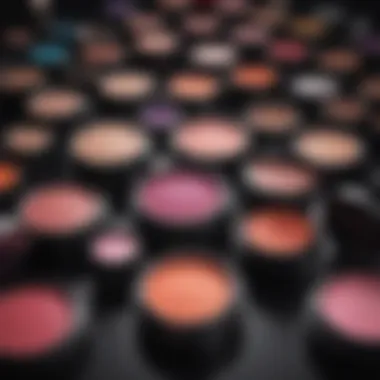A Comprehensive Guide to Toxin-Free Makeup Brands


Intro
In recent years, the beauty industry has seen a significant shift toward toxin-free makeup. Many consumers, especially women, are becoming more aware of what they put on their skin. This awareness is no accident; it stems from a growing understanding of the potential harms associated with certain chemicals often found in traditional cosmetics. Toxin-free makeup aims to eliminate harmful substances like parabens, sulfates, and synthetic fragrances.
The benefits of using these products go beyond just health implications. Many toxin-free brands also focus on sustainability and eco-friendliness. As a result, they are committed to using ethically sourced ingredients and implementing environmentally responsible practices. The trend aligns well with a more comprehensive shift in consumer behavior, where individuals prioritize their wellbeing and consider the broader impact of their purchasing decisions on the planet.
This guide will cover several critical aspects of toxin-free makeup. We will look into exemplary brands that have made a pledge to deliver safe and effective products. Furthermore, we will identify specific harmful ingredients to avoid and certifications that can indicate a product's quality. The guide will also provide tips to help navigate the choices available, offering insight into how to select products that meet both health and ethical standards. The objective is clear: empower readers to make informed decisions, enhance their beauty regimen, and embrace a toxin-free lifestyle.
Prelims to Toxin-Free Makeup
In recent years, toxin-free makeup has gained significant attention within the beauty industry. Consumers are now more educated and conscious about the products they use on their skin. This has led to a burgeoning demand for cosmetics free from harmful chemicals and toxins. Not only does this shift promote personal health, but it also encourages companies to adopt safer, greener practices. Understanding toxin-free makeup is essential for a health-conscious approach to beauty.
Defining Toxin-Free Makeup
Toxin-free makeup generally refers to cosmetics formulated without certain harmful substances. These can include parabens, phthalates, sulfates, and synthetic fragrances, which are often criticized for their potential health risks. Toxin-free products focus on using natural ingredients instead. This shift emphasizes transparency with consumers about what they apply to their skin. What is labeled as toxin-free may vary, but the core principle remains the same: prioritizing safety and purity over mere aesthetics.
The Rise of Clean Beauty
The concept of clean beauty is not entirely new but has recently accelerated. Many women today aim for products that are ethical, sustainable, and skin-friendly. Brands are responding by reformulating their products to fit these values. Clean beauty extends beyond avoiding toxins; it includes sourcing ingredients responsibly and ensuring environmental sustainability.
"The rise of clean beauty is a response not only to consumer demand but also to a broader movement advocating for individual health and the protection of our planet."
As more brands commit to clean formulations, it becomes easier for consumers to transition to safer, more effective makeup options. In this context, education and awareness become vital, guiding women in choosing products that reflect their values and health needs.
The Importance of Choosing Toxin-Free Products
In the ever-evolving landscape of beauty and skincare, the decision to opt for toxin-free products carries increasing significance. Choosing toxin-free makeup not only enhances personal well-being but also reflects a growing awareness about environmental sustainability and ethical sourcing. The implications of the products we use are manifold, impacting both our bodies and the planet. Understanding these elements helps consumers make informed decisions that resonate with their values.
Health Implications of Toxic Ingredients
Toxic ingredients are commonly found in many conventional cosmetics. These substances can disrupt hormonal balances, cause skin irritations, and in some cases, lead to more severe health conditions. For instance, substances such as parabens and phthalates have been linked to potential reproductive and developmental issues. Long-term exposure may contribute to health concerns like cancer and infertility. According to studies, many of these harmful chemicals can accumulate in the body over time, leading to chronic health issues.
Consumers are increasingly recognizing the importance of reading labels and understanding what is in their skincare and makeup products. Switching to toxin-free options minimizes the risk of exposure to these harmful substances. Even minor changes—like selecting products without synthetic fragrances or sulfates—can have a notable impact on overall skin health.
"Choosing toxin-free products is not just a personal choice; it is a commitment to wellness and vitality."
Environmental Impact of Conventional Cosmetics
The production and disposal of conventional cosmetics contribute significantly to environmental degradation. Many traditional beauty products rely on petrochemicals, which not only pollute the environment during manufacturing but also leave a lasting footprint. Additionally, the non-biodegradable nature of certain cosmetic packaging adds to landfill waste and ocean pollution.
Many toxic ingredients used in beauty products wind up in waterways, adversely affecting aquatic life and ecosystems. This chain of impact highlights why consumers should consider not just personal health, but the larger ecological consequences of their purchases.
Here are a few key points that illustrate the environmental concerns associated with conventional cosmetics:
- Chemical Runoff: Harmful substances enter water systems, negatively affecting wildlife.
- Waste Accumulation: Non-recyclable packaging contributes to increasing waste in landfills.
- Resource Intensive: Production processes may deplete natural resources and contribute to climate change.
Transitioning to toxin-free makeup is, therefore, not only beneficial for personal health but also vital for nurturing a sustainable future. By choosing products associated with clean beauty practices, consumers can help drive demand for ethical and eco-friendly beauty solutions.
Key Ingredients to Avoid
In the journey towards embracing toxin-free makeup, understanding the harmful ingredients commonly found in conventional cosmetics holds paramount importance. Many products harbo toxic substances that can lead to long-term health issues or skin sensitivities. By identifying these ingredients and opting for safer alternatives, consumers can protect their health, feel confident about their choices, and contribute to a more sustainable beauty industry. Let's explore the key ingredients to avoid in cosmetic products and their implications.


Parabens and Their Alternatives
Parabens are synthetic preservatives used widely in cosmetics to prevent the growth of bacteria and mold. However, they have been linked to hormone disruption, raising concerns about breast cancer risk. Parabens can mimic estrogen, a key hormone in the body, and their presence in products that women often use daily poses a potential health threat. Consumers should look for products labeled as "paraben-free" when seeking safer options.
To replace parabens, brands are increasingly using natural preservatives. Options such as rosemary extract, vitamin E, and grapefruit seed extract are gaining popularity. These alternatives not only help maintain product integrity but also support skin health without the risks associated with synthetic preservatives.
Phthalates: Why They Matter
Phthalates are a group of chemicals used to make plastics more flexible and are commonly found in fragrances used in cosmetics. These compounds are concerning due to their connection to endocrine disruption and potential reproductive harm. Studies indicate that exposure to phthalates can lead to various health issues, including developmental and hormonal deficits.
To minimize exposure, consumers should actively look for phthalate-free products. Fragrance-free alternatives are becoming more common, as many brands are committed to producing safer, eco-conscious options. Synthetic fragrances are often a cocktail of harmful chemicals; thus, choosing products with natural scents derived from essential oils is a better choice for health and wellbeing.
Synthetic Fragrances and Dyes
Synthetic fragrances and dyes add appealing scents and colors to cosmetics but can lead to allergic reactions and skin irritations in many users. The term "fragrance" can encompass hundreds of individual components, many of which are undisclosed due to trade secret laws. This makes it difficult to know what harmful ingredients one is putting on their skin.
Natural alternatives, such as plant-based oils and mineral pigments, not only provide color and aroma but also enhance the product's overall health benefits. These natural components often promote skin hydration and prevent irritation — key advantages over their synthetic counterparts.
It is essential for consumers to read labels carefully and educate themselves about the ingredients in their beauty products.
Recognizing Toxin-Free Makeup Brands
Identifying toxin-free makeup brands is crucial for those seeking safe and healthy products. In an industry often saturated with harmful ingredients, knowing which brands prioritize safety and sustainability can make a significant difference. The growing awareness of the detrimental effects of toxic substances in cosmetics necessitates a more informed approach to beauty. Recognizing reputable brands can help consumers align their choices with their health and ethical values.
Certifications to Look For
Certifications play a fundamental role in individual’s ability to identify genuine toxin-free brands. Several certifications provide assurance that a product has met stringent safety and environmental standards. Key certifications to be aware of include:
- ECOCERT: This certifies organic and natural cosmetics. Products must comply with specific environmental regulations and ingredient sourcing guidelines.
- USDA Organic: Indicates that at least 95% of the ingredients are organically produced, offering a strong statement about product purity.
- Leaping Bunny: This certification guarantees that no animal testing has occurred at any stage of product development.
- PETA’s Beauty Without Bunnies: Ensures that brands do not engage in animal testing and are committed to cruelty-free practices.
By looking for these certifications on packaging, consumers can feel confident in their purchases. It is important to remember that not all brands will have the same certifications. Thus, researching and understanding what each certification entails greatly benefits buyers.
Brand Transparency and Ethics
Brand transparency and ethics are essential aspects while recognizing toxin-free makeup brands. A brand that is open about its ingredient sourcing and manufacturing processes is more likely to adhere to toxin-free principles. Many brands today share detailed information regarding their formulations, business practices, and sustainability efforts. This transparency fosters trust among consumers.
Some points to consider regarding brand transparency include:
- Do they provide ingredient lists?
- Is there clarity on sourcing?
- Are there any partnerships with environmental or health organizations?
Ethical considerations include:
- Fair labor practices
- Environmental sustainability
- Community engagement
When choosing a brand, prioritizing those that demonstrate commitment to both ethics and transparency can lead to more informed decisions. In many cases, researching brand values through company websites or social media platforms, such as Facebook or Reddit, can reveal a wealth of information.
"A clear window into company practices fosters consumer confidence and supports healthier purchasing habits."
This approach not only aids in recognizing toxin-free brands but also supports broader societal goals like sustainability and ethical business conduct. Ultimately, understanding these elements allows consumers to make mindful choices in their quest for safer makeup products.
Profiles of Notable Toxin-Free Makeup Brands


In recent years, the makeup industry has seen a significant shift towards toxin-free alternatives. This change is a response not just to consumer demand for safer products but also to the growing body of evidence linking certain ingredients found in conventional cosmetics to various health concerns. Therefore, showcasing profiles of notable toxin-free makeup brands is essential in guiding consumers who seek safer and more ethical beauty options.
When evaluating these brands, several elements come into focus, such as their commitment to clean beauty, innovative formulations, and sustainable practices. By understanding these aspects, consumers can make informed choices that align with their values and health needs.
Brand A: Commitment to Clean Beauty
Brand A stands out for its unwavering dedication to clean beauty. This brand emphasizes transparency and integrity in its ingredient sourcing and manufacturing processes. Their product lines are formulated without harmful chemicals, earning certifications that affirm their toxin-free status.
Key highlights include:
- Transparency: Brand A provides detailed lists of all ingredients used in their products, ensuring consumers are well-informed.
- Third-party testing: Independent labs test their products to confirm the absence of toxic substances, further establishing trust.
This commitment not only enhances consumer confidence but also sets a precedent for other brands in the market.
Brand B: Innovative Formulations
Brand B excels in creating innovative formulations that challenge the conventional beauty landscape. Their research and development efforts focus on discovering new, safer ingredients that do not compromise on product performance.
Notable aspects of Brand B include:
- Research-driven: Each formulation undergoes rigorous testing to ensure effectiveness while remaining free from harmful toxins.
- Multi-functional products: Many of their items serve multiple purposes, reducing the need for a larger collection of products, which is also eco-friendly.
These innovations not only satisfy consumer preferences for performance but also highlight the potential for beauty products to be both effective and health-conscious.
Brand C: Sustainable Practices
Brand C adopts a holistic approach towards sustainability in their business operations. From sourcing raw materials to packaging design, every decision reflects a commitment to environmental responsibility.
Essential features include:
- Eco-friendly packaging: Brand C uses biodegradable, recyclable, or refillable packaging, minimizing waste in the beauty industry.
- Ethical sourcing: They prioritize fair trade practices and work with suppliers who meet ethical standards, supporting local communities.
By integrating sustainability into their core practices, Brand C not only serves its customer base but also contributes positively to the planet, appealing to environmentally-conscious consumers.
"Consumers today are not just buying products; they are investing in values. Brands that embody these values through clean formulations and sustainable practices are setting the future standard in beauty."
In summary, understanding the profiles of these notable toxin-free makeup brands equips consumers with the knowledge to choose products that are both safe and aligned with their values. Each brand offers unique advantages, from rigorous ingredient testing to environmentally responsible practices, enriching the beauty landscape and encouraging a shift towards healthier choices.
Navigating the Transition to Toxin-Free Makeup
Transitioning to toxin-free makeup is both a significant and rewarding step for many consumers today. It reflects an understanding of the potential impact of harmful chemicals on our health and environment. This process allows individuals to curate their beauty routines based on what is safest for their skin and aligned with their values. Prioritizing toxin-free products can lead to improved overall wellness and support sustainable practices in the cosmetic industry.
Identifying Your Needs
To begin this transition, it is essential to identify personal needs and preferences regarding makeup. Each person's skin type, sensitivities, and aesthetic goals vary widely. For some, it may involve switching foundation types, such as moving from liquid to powder formulas. For others, it might mean exploring brands that offer specific shades that accommodate their beauty looks.
Consider creating a list of the makeup products you use frequently. This can include mascara, blush, and lipsticks. Review the ingredients in these products to better understand harmful components to avoid, such as parabens or phthalates. Knowing what you currently use provides clarity when selecting toxin-free alternatives that meet your needs.
Being informed about skin reactions to various components can also simplify the search for suitable brands. Test patches and samples can help you find products that you can wear comfortably.
Phasing Out Conventional Products


Phasing out conventional products does not require an overnight overhaul of makeup collections. A more manageable approach involves replacing items as they run out. This way, it does not impose significant financial strain. Start with the makeup products most often in contact with the skin, such as foundations and primers.
When replacing products, look closely at certifications and labels that confirm products are truly toxin-free. The words "natural" or "organic" on a package can be misleading. It is vital to scrutinize ingredients to ensure they align with your toxin-free commitment. Consider also looking up online reviews or feedback on the specific brands to make more informed decisions.
Building a Sustainable Makeup Collection
Building a sustainable makeup collection takes both time and intention. Start by choosing brands recognized for their transparency in ingredients and sustainable practices. Research brands that advocate for eco-friendly packaging and ethical sourcing. This will not only ensure a cleaner beauty routine but also support companies that prioritize environmental responsibility.
Creating a minimalist approach may also be helpful. Focus on purchasing versatile products that serve multiple purposes. For instance, a tinted moisturizer can act as both a foundation and sunscreen, reducing the need for various items.
One of the most beneficial aspects of selecting toxin-free brands is the opportunity to educate oneself. Seek communities online or engage in social media groups dedicated to clean beauty. These platforms can provide valuable insight on new product launches, brand stories, and consumer experiences.
Transitioning to toxin-free makeup is not just about changing products; it’s about embracing a mindset focused on health and sustainability.
Ultimately, navigating your transition to toxin-free makeup can lead to a more thoughtful, health-minded approach to beauty. It emphasizes personal choice in aligning beauty rituals with one’s values and can foster a broader awareness of how our choices impact our well-being and that of our planet.
The Future of Toxin-Free Makeup
The landscape of makeup and beauty products is evolving. This evolution is essential as consumers become more educated about what they apply on their skin and its effects on health. The future of toxin-free makeup is not just a trend; it's a paradigm shift in the beauty industry. This shift marks an important turn towards safer, more sustainable, and ethical beauty choices. Embracing toxin-free makeup is increasingly viewed as an essential part of personal and environmental well-being.
Toxin-free makeup brands are expanding their offerings, driven by innovations in formulation and a commitment to clean sourcing. Brands are investing in new science-backed ingredients, moving away from harmful chemicals previously considered fine. This transformation highlights the importance of ingredient transparency and invites consumers to be part of the change.
Emerging Trends in Clean Beauty
Several emerging trends are shaping the future of toxin-free makeup. First, there is a growing interest in plant-based and organic ingredients. These are not only perceived as safer but also offer beneficial properties for the skin. Ingredients like shea butter and jojoba oil are becoming staples in formulations, replacing synthetic additives that once dominated the market.
Another trend is the rise of customizable beauty products. Many brands are taking a personalized approach, allowing consumers to create makeup tailored to their unique skin types and preferences. This trend emphasizes the idea that beauty is individual and can be enhanced through healthy choices.
In addition, sustainability is becoming a crucial aspect of product development. More brands are focusing on eco-friendly packaging and refillable options. This commitment to the environment resonates with consumers who seek to minimize their carbon footprint.
Consumer Demand for Ethical Brands
Consumer demand for ethical brands is a pivotal force driving the trend towards toxin-free makeup. Consumers are more aware than before of the negative impacts of conventional cosmetics on their health and the environment. They are actively seeking brands that prioritize ethics in sourcing, production, and ingredient selection.
This demand is compelling brands to adopt better practices. Companies are now more focused on social responsibility, ensuring fair labor practices and sustainable sourcing of raw materials. Furthermore, the trend reflects a broader cultural shift where consumers are willing to invest more in products that align with their values.
"As consumers become more conscious, the marketplace must respond to their demands for transparency, sustainability, and ethics in beauty products."
In summary, the future of toxin-free makeup is rich with possibilities. With awareness rising and demand growing, the industry is poised for significant transformation, leading to healthier options for consumers and a more sustainable planet.
Closure: Embracing a Healthier Beauty Routine
The transition to toxin-free makeup is not just a trend; it signifies a shift towards a more conscientious approach to beauty. In this article, we explored various aspects of toxin-free makeup and its significance. As consumers become more aware of the ingredients in their products, it is essential to embrace safer, more sustainable choices.
Choosing toxin-free makeup aligns with a broader commitment to health and well-being. Makeup products often contain harmful chemicals that can accumulate in the body over time. By opting for toxin-free alternatives, individuals can minimize exposure to potentially harmful substances. This choice promotes better skin health and reduces the risk of allergic reactions or irritations caused by synthetic ingredients.
Furthermore, embracing a toxin-free beauty routine contributes to environmental sustainability. Many traditional cosmetics use ingredients and packaging that are not eco-friendly. Toxin-free brands tend to prioritize sustainable sourcing and packaging, thus reducing the environmental footprint. This aspect appeals to the growing consumer demand for ethical and responsible brands in the beauty industry.
As consumers, it is vital to reflect on purchasing decisions. Supporting brands that are transparent about their ingredient lists and commitment to clean beauty encourages a market shift towards healthier options. Additionally, educating oneself about harmful ingredients and their alternatives can help make informed choices.
"The products we choose to apply to our bodies can have a profound impact, not only on our health but also on the planet."
The Long-Term Benefits of Toxin-Free Choices
The long-term benefits of choosing toxin-free makeup extend beyond immediate health effects. Initially, the switch may seem daunting, but the cumulative positive impact on health and well-being becomes evident over time.
- Skin Health Improvement: Regular use of toxin-free makeup can lead to significant improvements in skin condition. Without harmful chemicals, the skin can heal and rejuvenate, ultimately leading to a more radiant appearance.
- Fostering Ethical Consumption: By consistently choosing toxin-free products, consumers contribute to a shift in industry standards. This can influence more companies to adopt ethical practices and focus on cleanliness in their formulations.
- Reduction of Hormonal Disruptors: Many conventional makeup products contain ingredients that can act as endocrine disruptors. Long-term exposure can result in various health issues. Toxin-free alternatives help mitigate these risks, promoting better hormonal balance.
- Sustainable Practices: As more people demand toxin-free products, brands adapt their practices to comply. Sustainable farming, responsible sourcing, and eco-friendly packaging become the new standard, further benefiting the environment.



